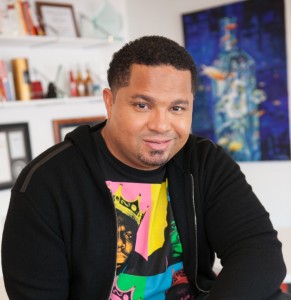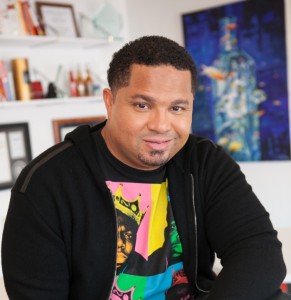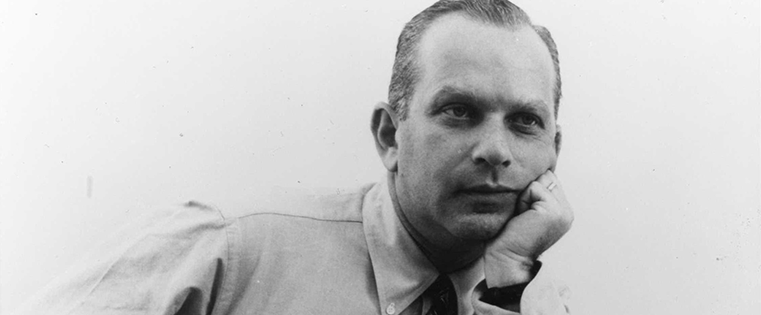 Welcome to The Agency Post. Tell us about yourself.
Welcome to The Agency Post. Tell us about yourself.
My name is Ahmad Islam and I am co-founder and managing partner of commonground, founded in 2004. We are based in Chicago with offices in Houston and Atlanta. I’ve been told that I’ve developed a reputation for shaking things up in the industry and making clients “comfortably uncomfortable” by pushing boundaries that ultimately drive the bottom line. This is one of the reasons commonground has been so successful and able to sustain long-term client-partner relationships. One of my favorite quotes that fuels my passion for the business happens to be from the great Michael Jordan: “Obstacles don’t have to stop you. If you run into a wall, don’t turn around and give up. Figure out how to climb it, go through it, or work around it.” I live and breathe this philosophy every day as I walk through the doors of my agency.

Prior to co-founding commonground, I started my career at Nike where I served in a variety of sales and marketing roles. After one very chilly winter in Minneapolis at Campbell Mithun, I jumped to Leo Burnett where I was vice president and account director on the U.S. Army business and part of the leadership team that launched the Army of One campaign. I also led the efforts of five multicultural agency subcontractors responsible for the execution of various Hispanic and African American targeted marketing programs. Essentially, I’ve been in the business for almost 20 years total between client and agency side experience. Advertising is a tough business, and I’ve learned through the years that having a true passion for marketing is one of the keys to long-term success in this industry. It is not a nine to five gig!
Tell us more about commonground. What type of work do you do?
The creation of our agency was inspired by the changing face of today’s marketplace, evolving client demands and the vision my business partner Sherman Wright and I share for building a place where a group of diverse, like-minded solution seekers driven by creativity and the desire to build brands that impact the world could come together and thrive. From advertising and shopper marketing to digital and social media programs, our unique blend of integrated services allows us to compete and win in head-to-head competition with larger global entities while also maintaining the nimbleness and entrepreneurial spirit of a startup. This combination allows us to stand apart in our industry, and we have a great team. We all have each other’s backs, and we come to work every day determined to make our shared experiences fun and rewarding. At commonground, we have lots of different personalities and lots of different ideas all working together to take our clients, our industry and our agency to a higher level… and so far it’s working!
Commonground recently was awarded Ad Age’s Small Agency of the Year, 11-75 Employees. How does commonground differentiate itself from other agencies? How are you continuing to grow the agency as a leader in the multicultural and cross-consumer marketing space?
We were very excited to win the Ad Age award. We’ve gotten a lot of love in the industry as a result of this national recognition, which speaks to the fact that we employ some of the best and brightest marketing minds in the industry and provide the very highest level of service to our client partners. We differentiate ourselves in very clear ways. One, we aren’t trying to be all things to all people. Two, we have a very nuanced approach to marketing because we understand that we’re living in the digital age. We are an agency that thrives at the convergence of creativity, strategy and technology. Our approach allows us to have a different outlook on how to transform passive consumers into passionate brand advocates. Digital is integrated into the core of all ideas, and we find the most relevant way to build sustainable and transformative brand relationships that move the needle. Our success is highlighted both by our steady growth as well as the blue chip brands that have entrusted us as their business partners. These partners include Coca Cola, Nike, MillerCoors, Unilever, Wrigley and Target to name a few. Our eclectic mix of marketing professionals allows us to provide our clients with a unique lens through which we view the world and connect with the consumers they desire to reach.
Where do agencies and brands most often fail when attempting to market to a diverse audience? What brands are achieving success?
Far too often, clients and brands attempt to take a “one size fits all” approach to connecting with diverse audiences, ignoring the unique insights and nuances that are often the difference between a particular audience “hearing” your message versus establishing a true emotional connection with them. While there are definitely universal truths that exist and provide a common thread across multiple consumer segments, those truths are not a magic silver bullet that removes the importance of the developing work driven by insights into diverse audiences. The key to winning with diverse audiences is the combination of segment-specific insights, as well as an understanding of the impact these diverse groups have on the behavior of the masses. McDonald’s and Nike are brands that have a long track record of “getting it.” Recently, Coors Light has also shown strong performance in targeting and winning with multiple diverse audiences.
Some brands are beginning to work to market to a mainstream audience instead of creating a campaign targeted at a specific demographic. commonground has worked on marketing campaigns for Coors Light that have used this approach. Does this type of work only succeed in the food and bev market? Or do you think this approach could be translated to work in various different industries?
To be clear, our recent Coors Light work was anchored in African-American/urban insight and sensibility, yet also appealed to the masses. When developed and executed properly, campaigns with the ability to identify and leverage insights and approaches rooted in multicultural sensibility have application well beyond the food and beverage industry. For many brands across numerous categories, a body of work that has a mix of communications targeting the mainstream as well as work targeting specific demographics all rooted in a tight, rock solid strategic foundation and positioning is the ideal solution. Not every brand can afford that solution, in which case tradeoffs must be made.
What does this “mainstream” trend reveal about today’s consumer? What is this consumer’s mindset and media consumption like?
The term “mainstream,” which is still often used to refer to the general market and, in many cases white consumers, is in many ways an irrelevant term in today’s marketplace. Depending on the demographic makeup of the consumer group you are trying to reach, what was once the majority is or very soon will become the minority, and with that comes a change in how brands and their agencies must approach connecting with these consumers. The importance of psychographics rooted in lifestyle and culture must be strongly considered — not completely at the expense of standard demographic data, but as a very valuable supplement to it. At the same time consumer mindset and the make-up of the mainstream is shifting, media consumption habits are also evolving. We live in a world of immediate access to information, content and selective two-way engagement where brands no longer control the dialogue.
The continued explosion of digital, social and mobile mediums — especially with younger consumers — has caused marketers to reconsider their approaches to media. The trick is to develop a mix of media that lets the brand leverage the strengths of each medium that allows them to engage consumers in meaningful, engaging and sustained dialogue. Dialogue that they no longer completely control, but must effectively navigate to win with their consumers.
Is ethnic targeting in advertising effective for reaching a specific market? Can this approach drive away consumers who don’t feel represented in the campaign?
To quote Bart Simpson, “Au contraire mon frère.” If properly executed, advertising that leverages multicultural insights to reach a specific audience will also deliver strong relevance with a broader group of consumers. The key is in insights and execution. A piece of creative can be partially anchored in a broad reaching insight that will resonate with various diverse consumer groups, but also tap a specific cultural insight that will enhance the work’s ability to connect with the appropriate diverse audience.
How do the African American and Hispanic demographics influence the general market? Why should brands make engagement with these ethnic groups a priority?
When Sherman and I first started commonground, we initially envisioned a niche-marketing agency that would merge the traditional consumer base with the rapidly evolving multicultural population. But instead of bringing this diverse marketplace to the mainstream, we’ve managed to build an impressive roster of client partners by moving middle America to where the growth is. We understand and believe that ALL brands who want to remain relevant should also understand that it has become a business imperative to seek “common ground” with multicultural audiences. When you really think about it, it’s impossible for any brand that wants to be successful to ignore the influence, impact and importance of multicultural people. Brands need to tap into that culture as a part of their marketing efforts. That’s where the growth is, so that’s where the opportunity is.
Multicultural consumers, especially African Americans, have tremendous influence on the masses. While the African American segment is the smallest in terms of population and buying power, they are in fact the most influential in terms of their propensity to create and embrace trends, brands and products that ultimately appeal to the masses. Of the three, the African American segment is the only segment that deeply and consistently influences the other two (Hispanic and general market). Technology and social media in particular have changed the influence game and further amplified the ability of multicultural consumers to impact the opinions, behaviors and buying habits of the general population. What once would take months, if not years, to move from the arbiters of urban cool to the masses can now be accomplished in weeks, days and sometimes even hours. Brands that are true thought leaders are not only embracing the importance of making their relationship with multicultural consumers a priority, they are leveraging the impact and influence of these consumers to shape and drive their broader general market efforts.
A 2012 report from the Labor Department’s Bureau of Labor Statistics states that less than 1 percent of those working as advertising managers are African American and 9.6 percent are Hispanic. How do you think the industry needs to evolve in order to recruit and maintain a culturally diverse group of talent, especially at the leadership level?
Leaders are grown, not magically created. To recruit and maintain talent in leadership roles, agencies must invest in recruiting, developing and retaining young, talented multicultural marketers. The current lack of diversity in the industry is an unfortunate reality that absolutely has an adverse impact on the ability of many agencies to provide their clients with a truly diverse lens into today’s marketplace. For the issue to truly be addressed, client and agencies must understand that diversity is an intelligent business practice that will positively impact the bottom line, not something that is “nice to do.”
Why should this be a business issue for brands looking to work with an agency?
Again, diversity allows an agency to bring a diverse perspective to their clients’ business challenges. Not just ethnic diversity, but diversity of experience, culture and perspective. The cumulative impact of this diversity is an agency that can bring a differentiated contemporary point of view to their clients’ business challenges. It allows agencies to approach their clients’ business challenges based on what is best for their business versus the agency’s homogenous lens to the world.
How do you see the multicultural marketing space evolving in the next two to three years?
I see the influence and impact of multicultural consumers continuing to grow over the next several years and with that, the importance of understanding how to best reach those consumers. The Hispanic market will continue to grow, become more acculturated and more fragmented. African-American buying power and influence will have an even greater impact on the behaviors and choices of the masses and the brands trying to reach them. The Asian market will present a new complex opportunity for many brands. Add to that the ever-changing media landscape, and it is going to be a very exciting and challenging next few years for brands and agencies in the multicultural space. Brands can no longer treat multicultural marketing as an afterthought and expect to be successful. Those that do will face significant challenges and decreasing revenues in the coming years.
Favorite Ad of All Time: Too many to name, I’ve been a commercial junkie since I was a little kid.
Mentor: Honestly, I don’t have one main mentor. I’ve been fortunate to have many talented and generous advisors and mentors throughout my career who have invested their time and expertise into helping me become the marketer that I am today. I try to pay that forward in turn by mentoring and providing opportunities to young diverse marketers as part of commonground’s mission.
Must read book: “Steve Jobs: A Biography.”
Anything else you’d like to add? Yes. Autism advocacy and awareness is a cause that my family and I support wholeheartedly. Wherever I go and whatever I do, my goal is to always speak out on behalf of families with autistic loved ones. My 9-year-old son, Gabriel, is one of the most amazing people I will ever be blessed to know and love. He was diagnosed with autism five years ago, and we are grateful to have the support and resources to make sure Gabriel lives a full, productive life filled with love. Sadly, there are many families that do not know where to go to get the proper support for their children, especially African American or Latino children who, statistics show, are often diagnosed later in life than white children. My wife Debra and I recently founded Gabriel's Horn Foundation to honor our son and all autistic children from underserved communities. Debra and I want all families to know that there are resources, people and information out there that can help them do what ultimately is in the best interest of the child. Gabriel’s Horn Foundation gives us the platform and opportunity to align closely with organizations like Autism Speaks to implement activities targeted toward multicultural families.
The Agency Post readers can follow Gabriel’s Horn on Twitter @gabrielshorn1. They can also visit autismspeaks.org to learn about the many ways they can support this meaningful cause.
Connect with Ahmad on LinkedIn, Facebook or on Twitter @AhmadCG.

![21 Quotes on Advertising From Howard Luck Gossage [Infographic]](https://blog.hubspot.com/hubfs/%5BAgency_Post%5D/Blog_Images/gossage-quotes.jpg)


![Judy Wellfare of Plus on Dynamic Storytelling and Culture as Currency [POV]](https://blog.hubspot.com/hs-fs/hub/53/file-1890516411-jpg/blog-files/judy-welfare-plus-199x300.jpg)
![Jamie King of Camp + King on Brand Control and the Art of Advertising [POV]](https://blog.hubspot.com/hs-fs/hub/53/file-1525579750-jpg/blog-files/jamie-king-291x300.jpg)
![Buzz Radar Creates Social Command Centers for Brands [Tech Profile]](https://blog.hubspot.com/hs-fs/hub/53/file-1520157779-jpg/blog-files/buzz-radar.jpg)
![Sean Lyons of Havas on Risk-Taking and Designing an Agency for Collaboration [POV]](https://blog.hubspot.com/hs-fs/hub/53/file-1520156274-jpg/blog-files/sean-lyons-237x300.jpg)
![John Pohlman of Lawrence & Schiller on Building Category Experience and Changing Its Agency Structure [POV]](https://blog.hubspot.com/hs-fs/hub/53/file-1524891732-jpg/blog-files/john_1-1-e1405443798105-300x280.jpg)
![Nico Coetzee of KPI Boutique on Performance Marketing and Agency Waste [POV]](https://blog.hubspot.com/hs-fs/hub/53/file-1524891282-jpg/blog-files/32e8bb2-300x300.jpg)